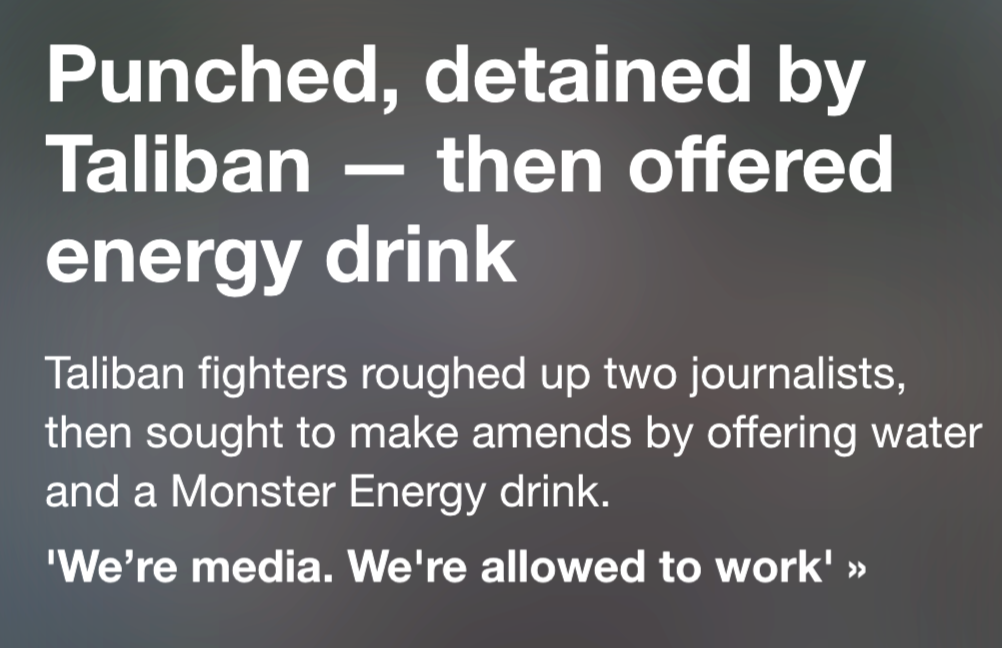The only thing funnier than just shooting a journalist in the head and leaving their corpse in the street as a warning is to gut punch them and then offer them a Monster energy drink.
Marcus Yam writes for the LA Times:
Then gunfire rang out and the crowd started to scatter. The burly fighter turned to see the commotion. I tried to slowly move away, and that’s when he turned and took a huge swing at me that knocked me down. My spectacles flew off my face.
I could see him gripping his Kalashnikov tighter, and I felt intense fear. The big man kept yelling. The best thing I could do was try to deescalate. I raised my hand and told him, “Please do not hurt us. We’re journalists, we’re foreigners.” We kept saying: “We’re media. We’re allowed to work.”
At that moment, members of the Taliban special forces — a unit called 313 Badri — showed up to clear the square of any remaining protesters. They marched right past us. With the Taliban fighter still standing over us, I had to fight every instinct in my body not to raise the camera and take a picture of the scene.
My thoughts were in a swirl. I felt disoriented; my head was throbbing. But my mind raced through options to get out of this situation without any more violence.
Then, a surprise: The radio-wielding Taliban revealed that he was able to speak and understand English. He insisted we delete the images of what had just happened. We repeated that we were journalists, that we were documenting the news.
Radio Taliban, as I’d started to think of him, had by now decided to treat us a lot better. He started asking how we were feeling, if we needed to go to a hospital. He suggested bringing us to a safer location, which sounded to me like a code word for detention. So we declined and asked politely to be allowed to return to our offices. Continuing to speak, he moved us out of the hot sun to a shady corner, asking us who we worked for.
After we named our publications, his expression changed.
He apologized profusely for our troubles, but not for beating us. They became solicitous: We were each brought a bottle of cold water and a can of Monster Energy drink, a favorite of the U.S. soldiers who controlled the city until a few days ago.
Radio Taliban asked us: “Please, could you tell me who hit you? We will capture him, and punish him.” I looked at my colleague in disbelief.
It was a surreal scene. The day before I’d been at a news conference in which the Taliban made promises about a brighter future, a free press. We kept repeating that we needed to return to the safety of our offices.
Our captor asked for a phone number for our driver. Instead, I pulled out a burner phone and called my driver on it, then passed the phone to the Taliban fighter. They coordinated, like people arranging a coffee date, and after a few minutes, we were escorted to our vehicle.
You’ve done it, Yam.
By God, you’ve done it.
Pure Gonzo.
It’s 2021, and you pulled off pure Gonzo in the LA Times of all places.
We should have predicted that in current year, the Chinese would be the only ones with the efficiency to pull off Gonzo.
We can’t build our own cellphones or computers or light switches, only the Chinese can manage it.
Just so is the situation with Gonzo journalism.
Imagine all of those faggots at The Daily Beast trying to do Gonzo, then this nerd Chinaman shuffles in and pulls it off flawlessly like it’s nothing.
Of course, the reason the Taliban likely chose not to beat him to death was that some sharp-eyed fighter realized he was Chinese and not Tajiki.
I never thought I’d say this to a modern journalist, Yam, but here it is: when your book comes out, I’m gonna download a bootleg copy from Library Genesis.
Jolly good show.
A word to the Yam: Ralph Steadman is still alive, and I’m sure he’d enjoy drawing pictures of the fall of Kabul.
Just don’t call it “Fear and Loathing in Kabul.” I think that would just be too pompous.




